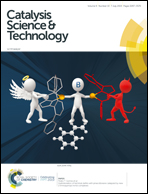Unravelling the catalytic influence of naturally occurring salts on biomass pyrolysis chemistry using glucose as a model compound: a combined experimental and DFT study†
Abstract
Fast pyrolysis is an efficient thermochemical decomposition process to produce bio-oil and renewable chemicals from lignocellulosic biomass. It has been suggested that alkali- and alkaline-earth metal (AAEM) ions in biomass alter the yield and composition of bio-oil, but little is known about the intrinsic chemistry of metal-catalyzed biomass pyrolysis. In this study, we combined thin-film pyrolysis experiments and density functional theory (DFT) calculations to obtain insights into AAEM-catalyzed glucose decomposition reactions, especially forming major bio-oil components and char. Experiments reveal the difference in the yield and composition of bio-oil of metal-free and AAEM complexed glucose. Metal-free glucose produced 2,3-dihydro-3,5-dihydroxy-6-methyl-4H-pyran-4-one (DHMDHP) as the predominant compound in bio-oil, while 1,6-anhydroglucofuranose (AGF) was dominant in Na(I)/glucose, levoglucosan (LGA) in K(I)/glucose, levoglucosenone (LGO) in Ca(II)/glucose and furfural in Mg(II)/glucose. To evaluate the stereoelectronic basis of metal ions in altering pyrolysis reaction kinetics, the reaction mechanisms of AGF, LGA, 5-hydroxymethylfurfural (5-HMF), furfural, 1,5-anhydro-4-deoxy-D-glycerohex-1-en-3-ulose (ADGH), LGO, and char formation were investigated using DFT calculations. DFT results showed that the presence of Ca(II) and Mg(II) ions catalyzed furfural and LGO formation, while alkali ions decatalyzed the formation of these products. Conversely, Na(I) and K(I) ions catalyzed the concerted dehydrative ring closure of glucofuranose during AGF formation. For ADGH, AAEMs showed an anti-catalytic effect. We also described a novel route for char formation via coupling between 1,2-anhydroglucopyranose and a carbonyl compound. The presence of alkali ions catalyzed char formation. Thus, the atomistic insights obtained from DFT calculations assist in understanding the observed change in experimental yields of individual bio-oil compounds governing their composition.



 Please wait while we load your content...
Please wait while we load your content...